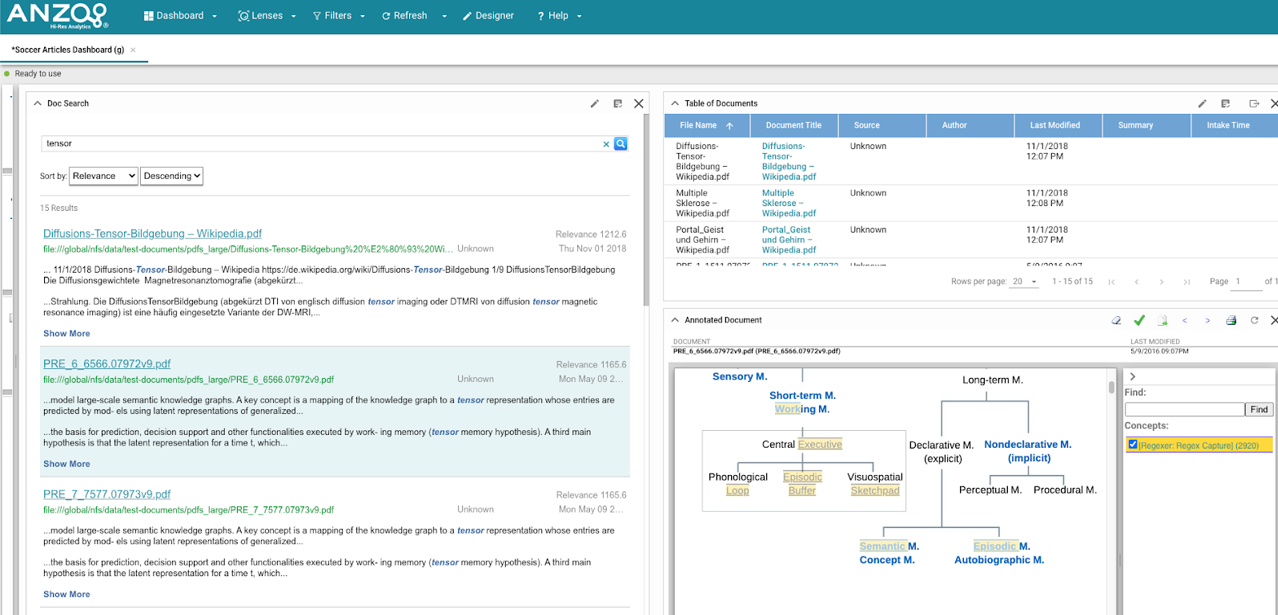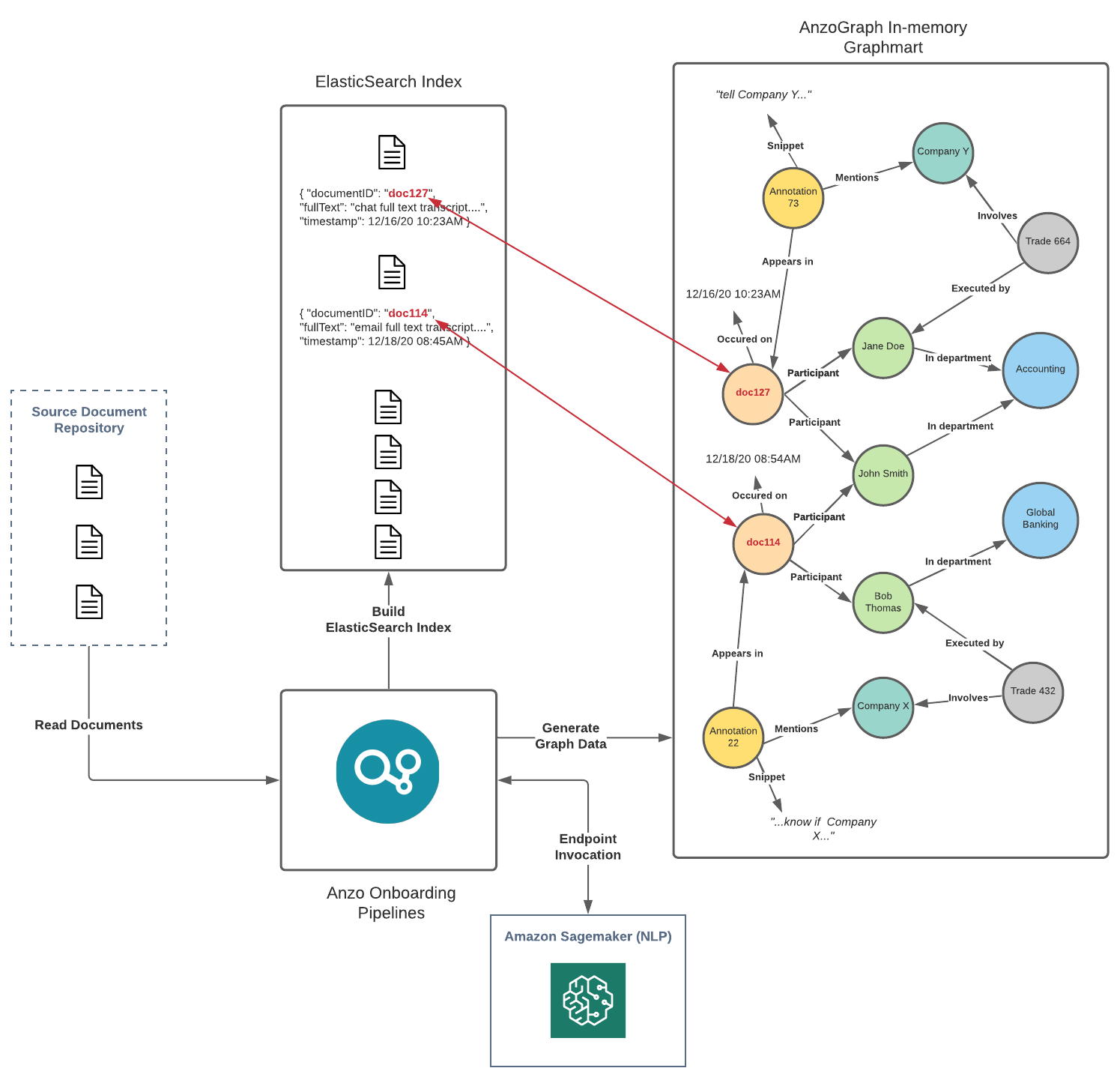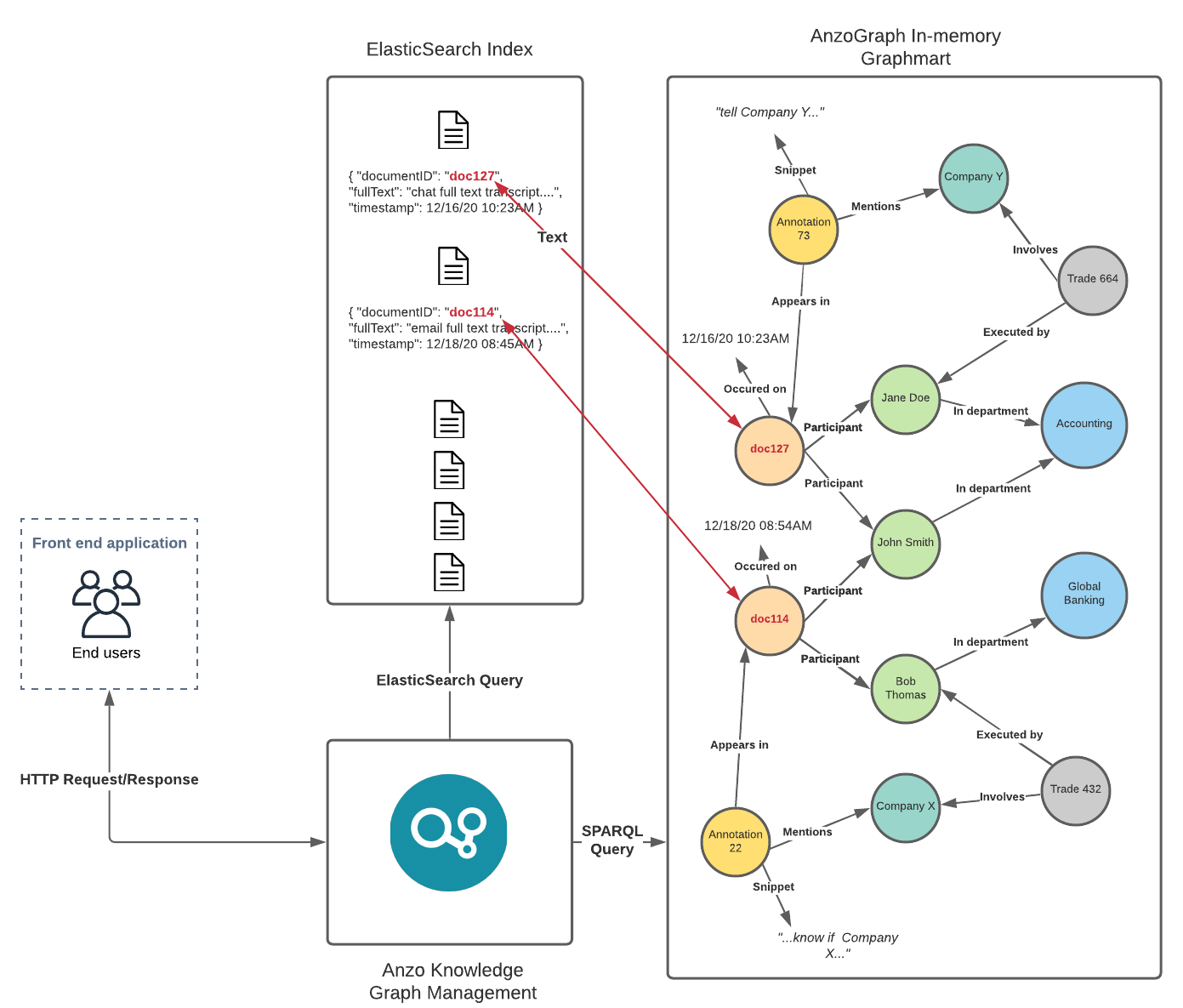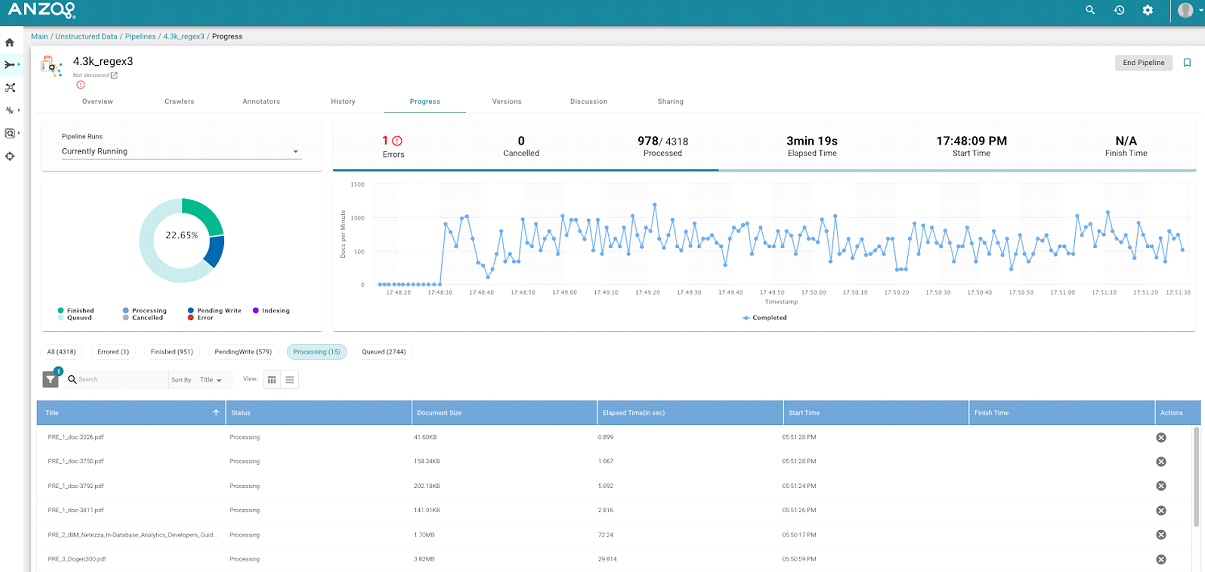Anzo Unstructured Overview
One of Anzo’s differentiators as a leading enterprise knowledge graph and data integration platform is its treatment of unstructured data as a first-class citizen in the knowledge graph. Anzo onboards unstructured data—sources that contain text, such as PDFs, text messages, or text snippets embedded in structured data—directly into the knowledge graph using configurable, scalable unstructured data pipelines. These pipelines generate a graph model for the unstructured text and extracted metadata, and they create connections in the graph between these elements and related entities so that the data can be fully integrated into the knowledge graph. In addition, the pipelines build an Elasticsearch index that can be used for highly performant, fully-integrated search queries that look across both free-text and semantic relationships within the knowledge graph.
The following sections provide an overview of the key features of Anzo’s unstructured data integration capabilities.
- Support for a Variety of Sources
- Text Processing and Annotation
- Text Indexing and Searching
- Scalability and Progress Tracking
Support for a Variety of Sources
Anzo’s onboarding pipelines can process unstructured text from a large variety of data sources and formats. Configurable crawlers determine what unstructured text a given onboarding pipeline will process. The crawlers can locate and extract text from files of a variety of formats, including PDFs, emails, HTML files, and Microsoft Word documents.
Anzo’s unstructured onboarding pipelines can also be configured to crawl the knowledge graph itself for unstructured content to index and annotate—whether the graph contains free-text directly or references to locations of documents. When combined with Anzo’s data virtualization capabilities (see Blending Data from Remote Sources (Preview) for more information), this presents a flexible and powerful framework to rapidly process unstructured data and bring it into a knowledge graph from practically any source or repository in a modern data ecosystem. Anzo’s data virtualization capabilities allow users to pull directly into the graph up-to-date structured file metadata from document repositories or unstructured text data stored in external systems. The resulting graph can then be seamlessly passed on as an input to unstructured processing pipelines.
Text Processing and Annotation
As a baseline, unstructured pipelines in Anzo extract basic metadata about each document that they process, such as file location, file size, title, author, etc., and store this metadata within the knowledge graph according to a standardized graph model. The pipelines generate HTML versions of the document that can be rendered in a browser, and references to the document’s original binary are maintained in the graph. With this, unstructured content and its associated metadata can be connected and queried alongside any other information stored in the knowledge graph.
Beyond this baseline processing capability, Anzo enables more advanced annotation of unstructured text. Built-in, configurable annotators allow Anzo’s unstructured pipelines to pull out facts or references in the text as annotations. Anzo adds the unstructured text data as well as these extracted annotations to the knowledge graph, where they are described by a graph model (ontology) that is dynamically generated by the onboarding pipeline. Additionally, the unstructured pipelines align the annotation spans to the source text and include highlights of the annotated text in the rendered HTML version of the document. Once in the knowledge graph, the unstructured annotation data can easily be discovered, explored, and connected alongside basic document data as well as any other enterprise data in the graph.
The image below shows an HTML rendering of a document and its highlighted annotations in an Anzo Hi-Res Analytics dashboard:

Anzo’s built-in annotators offer annotation capabilities based on pattern matching and taxonomies or dictionaries of terms that already exist in the knowledge graph. Anzo’s unstructured pipelines also offer a flexible and agnostic extension framework to support integration with external NLP engines that can provide domain-specific or ML-driven text processing capabilities (for example, Amazon Sagemaker, spaCy NER, Amazon Comprehend, etc.). With simple configurations, Anzo’s pipelines provide unstructured plaintext to these external components, and then bring their output back into the knowledge graph, dynamically generating a graph model and connecting the extracted annotations to the document metadata and related entities. This can serve not only as an effective way to integrate state-of-the-art NLP insights alongside related data in a knowledge graph, but also as a flexible and transparent paradigm for validation and analysis of ML-driven NLP development.
Text Indexing and Searching
Natively, Anzo’s unstructured pipelines create an Elasticsearch index of all unstructured files onboarded to Anzo. These indexes contain references to URIs of related entities in the knowledge graph so that the indexed data be joined directly against the rich and highly connected knowledge graph. When coupled with AnzoGraph’s native Elasticsearch SPARQL extension, this allows a truly state-of-the-art integration. Users can leverage AnzoGraph’s MPP engine and seamlessly execute queries that combine scalable, performant free-text search alongside complex, semantic queries against the graph. Both elements of the query are computed in a highly parallelized manner, resulting in unmatched query performance. This integration can serve as a strong and flexible foundation for advanced, complex modern search applications.
The diagram below shows an overview of Anzo Unstructured’s Elasticsearch integration during pipeline processing:

The following diagram shows an overview of Anzo Unstructured’s Elasticsearch integration during querying and analysis:

Scalability and Progress Tracking
Anzo’s unstructured pipelines run using a highly distributed and performant microservice cluster built using Akka. Worker nodes, which perform text processing in parallel, can be scaled out and up to increase the processing throughput of the pipeline. With this parallelization and scalability, Anzo’s pipelines are capable of processing tens of thousands of unstructured documents per minute. The pipeline processing services can be deployed alongside Anzo on standard hardware or cloud instances, or they can be spun up dynamically using Anzo’s native Kubernetes integration (see Using K8s for Dynamic Deployments of Anzo Components for more information).
To track the progress of unstructured data pipelines, Anzo offers a user interface that reports fine-grained status information about each document and its processing status, as well as any issues encountered in processing. The user interface also shows global statistics about a given pipeline run, including overall processing throughput, percentage complete, time elapsed, etc. This reporting module gives system administrators a centralized view of processing progress and an easy way to oversee the pipeline as it operates.
The image below shows Anzo’s reporting interface on unstructured pipeline progress:

For more information about unstructured pipeline processing and the resulting artifacts, see Anzo Unstructured Data Onboarding Process.